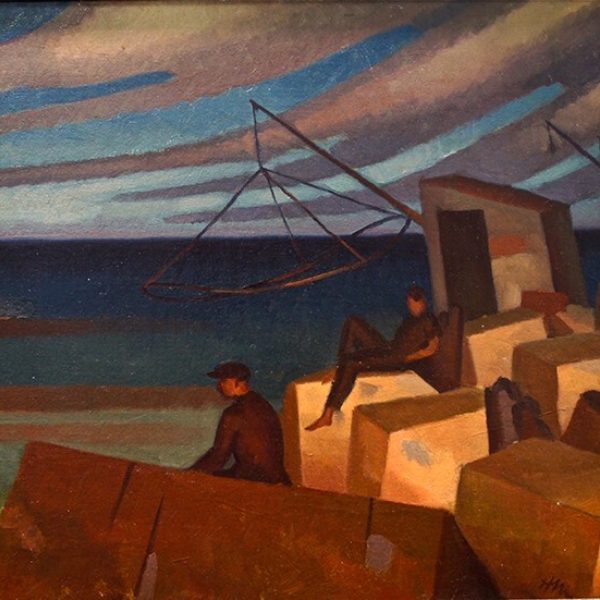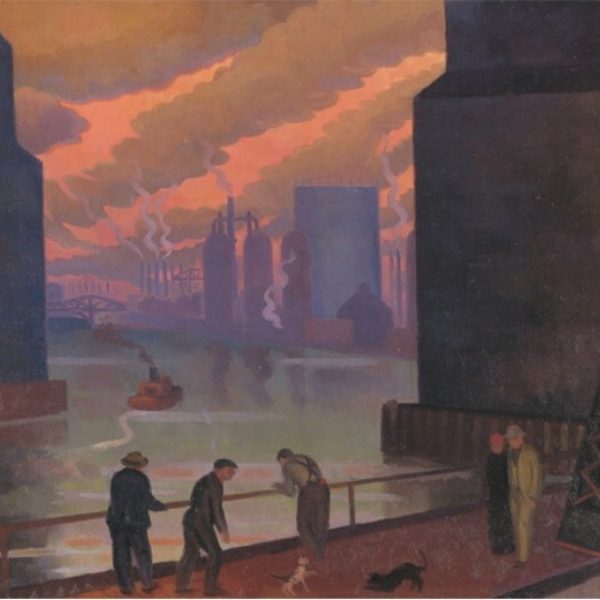Herman Menzel
b. 1904, Chicago, IL - d. 1988, Winnetka, IL
Born in 1904, Herman Menzel grew up speaking German at home in the Hamilton Park neighborhood of Chicago, where his father was the pastor of a German Lutheran Church. As a child he developed a passion for fishing in the undeveloped areas close to his home where lakes were still abundant with sunfish, bullheads, and catfish. His interest is reflected in the many paintings he did in which fishermen cast their lines from the shore of Lake Michigan (such as Untitled [Smelt fishing]) or Calumet Harbor, of boats in the calm waters of a Minnesota lake, or in the idiosyncratic images of people looking at the displays in the newly opened Shedd Aquarium in Chicago, which he made in the late 1940s and 1950s. Menzel also became interested in drawing and sketching as a child, and in 1922, after graduating high school, he enrolled at the Chicago Academy of Design, followed by the newly opened National Academy of Art, a commercial art school, where he met Willa Hamm, his future wife.
In 1924, the couple followed their teachers Marques Reitzel and Charles de Witz when they left the Academy to start the Studio School, where Menzel studied with John Warner Norton and William Bishop Owen, who encouraged him to pursue fine art rather than the commercial path—advice Menzel took to heart. His experiences with these teachers, who took their students on sketching trips around Chicago, inspired him to depict the ordinary pleasures of the city, such as skaters, swimmers, and most distinctively, the immigrant denizens of the Mexican poolrooms that were plentiful on Chicago’s South Side in the 1920s. The immigrants were part of an insular community that may have even been threatening to Menzel, whose experience of exclusion from the mainstream as a German speaker during World War I, made him sympathetic to this marginalized group.
Willa rented a studio at 229 East Huron Street in 1929, at the beginning of her long and successful career as a commercial artist. The couple frequented jazz clubs and explored the city together. He and Willa married in 1933 and lived on the South Side, sharing models with Frances Strain, Fred Biesel, Frances Foy, and other artists in the 57th Street Art Colony studios, housed in the outbuildings of the 1893 World’s Columbian Exposition. By this time, Herman was virtually deaf, and although he exhibited in several juried Art Institute of Chicago Annuals between 1927 and 1939, and once with the Chicago No-Jury Society, and in a few exhibitions in other cities, he became increasingly isolated and did not exhibit his work in later years. He did participate in the Illinois Art Project on one occasion, submitting a work at the request of one of the administrators. Because Willa had a full time job, however, he was not eligible to apply for regular employment on the easel project.
In 1943, Herman and Willa and their one-year-old son, Sewall, moved to Willa’s familial home in the Hubbard Woods section of Winnetka. Herman built a studio in the yard where he worked while Willa commuted to Chicago for her job, which allowed him to paint without concern for patrons, galleries, museums, critics, or the need to please anyone but himself. He became increasingly detached from the art world while Willa remained his constant supporter and booster of his work throughout his life and after his death as well. Herman’s love for the out of doors, stimulated by visits to his brother-in-law’s farm in central Illinois and several trips to Woodstock in the late 1920s, as well as his childhood wandering in the less urban areas of Chicago, culminated in the purchase of an island in Rainy Lake, on the Minnesota-Ontario border in the late 1930s. There, Herman built a cabin, fished, and sketched from nature; the many images of an isolated fisherman in a vast landscape are the result of the visits he made to this secluded retreat where he enjoyed both the solitude and the hard physical labor of rustic life.
Despite his disinterest in the art community of Chicago, Menzel shared with them an interest in the Ashcan School with its representational style and emphasis on freedom of expression. In the 1920s, Herman became an avid admirer of Robert Henri’s book, The Art Spirit, which validated his own search for individual expression through his art. The artists associated with this group were widely respected among Chicago progressives and had frequent exhibits at the Art Institute during the early twentieth century. Not as radical as the proponents of European modernism, they resonated with many young Chicago artists. Menzel's industrial landscape, Bridges, South Chicago, combines the geometric forms and dark tones of the factory towers, smokestacks and steel works with both the organic exuberance and rich colors of the sky and smoke and with the people and dogs in the foreground.
In Untitled (Smelt fishing), Herman not only incorporated his personal love of the sport and the pleasure of this quiet, isolated activity, but also the alienating quality of urban life, more in the vein of Edward Hopper than the Ashcan School artist George Bellows. Menzel’s faceless fishermen don’t interact with each other but look out to the glassy blue water of the calm lake with which they commune while waiting for a catch. The simplification of form, the geometric shapes of the rocks, and the reduction of the clouds to patterns all speak to his familiarity with twentieth-century modernism. The overall visible application of paint in Menzel’s characteristic v-shaped strokes functions as a distinct formal element, setting up a tension between the paint surface and that which is represented. The painting represents the border between the city and the world of nature, and the romance and poetry of that juncture, a perennial interest of Menzel and his unique vision.
Susan Weininger
References
Greenhouse, Wendy, and Susan S. Weininger. A Rediscovered Regionalist: Herman Menzel. Chicago: Chicago Historical Society, 1994.
——. Chicago Painting 1895 to 1945: The Bridges Collection. Exh. cat. Springfield: University of Illinois Press and Illinois State Museum, 2004.
Weininger, Susan. “Herman Menzel.” In Chicago Modern, 1893–1945: Pursuit of the New, edited by Elizabeth Kennedy, 129. Chicago: Terra Museum of American Art, 2004.

